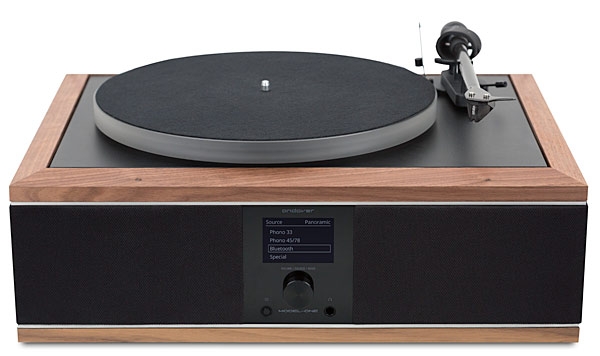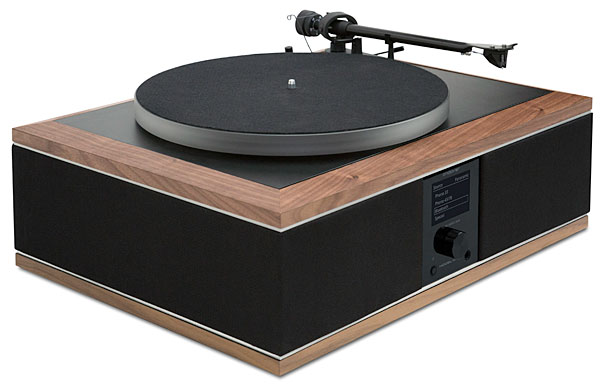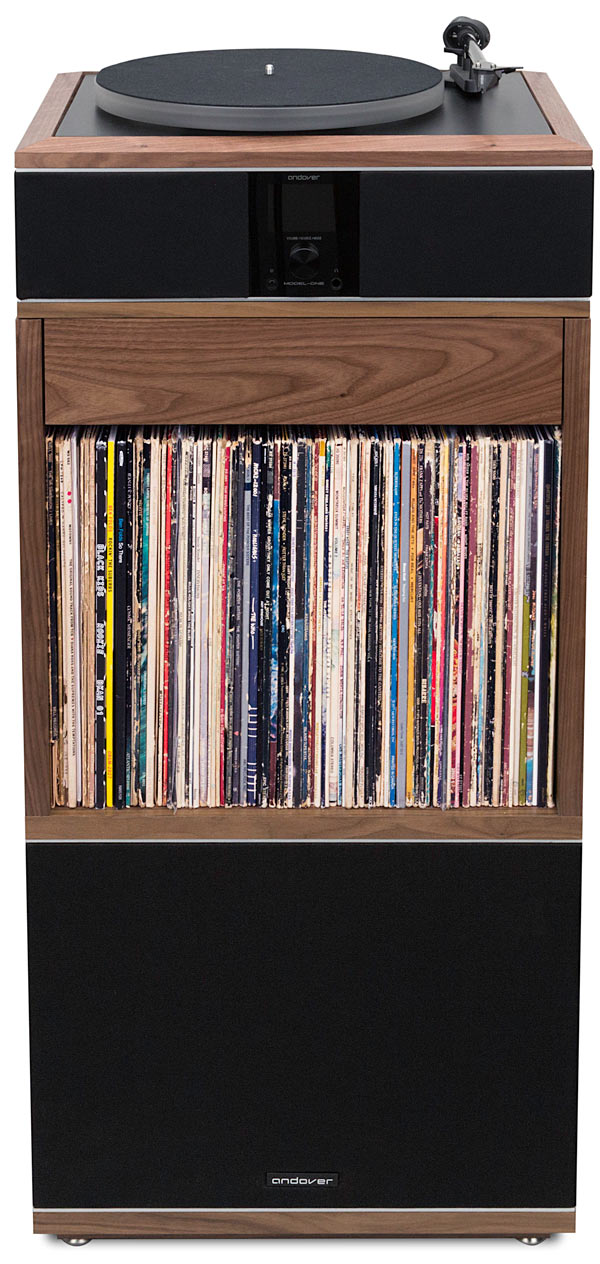| Columns Retired Columns & Blogs |
Although not exactly the same as Andover Music System, may be JM could also review the Naim Mu-so 2 wireless music system, $1,600 :-) .......

I was hooked.
Fast-forward to the present, when integrated vinyl-playback systems have come a long way with technology, materials, and design. Still, an "all-in-one" system can raise an audiophile's hackles, and for, um, sound reasons (pun intended): The more you pack into a single chassis (or speaker enclosure or whatever), the more can go wrong. There are noise considerations and spatial limitations, vibrations and feedback. Some audiophile readers might be reminded of furniture-like stereo consoles from their youth that, while some of them sounded pretty good, were not the pinnacle of hi-fi.
Now Andover Audio has created the Model-One, an integrated turntable system that's intended to have broad crossover appeal, or anyway, to appeal to music lovers who aren't members of the audiophile set. I noticed that the Model-One intrigued some guests of audiophile attendees when I first encountered it at the 2019 New York Audio Show.
Overview
The Model-One packs a lot into a single enclosure: a record player with speeds of 33.3, 45, and 78rpm; an internal phono preamp and amplifier; an ADC and a DAC; a headphone amp; and built-in speakers. It comes with a matching, full-function remote control. All this can be yours for just $1999.
A moment's thought leads one to the conclusion that a turntable sitting on top of a loudspeaker is problematic. Loudspeakers vibrate. Turntables—rather, phono cartridges—are designed to respond to vibrations.
To address that challenge, and other sonic challenges inherent in an integrated-turntable all-in-one unit, the Model-One leverages sophisticated audio technologies, including specialized DSP, that were originally developed for other product categories and applications.

I spoke with Bob Hazelwood, Andover's director of product development/head engineer, via Skype. Andover Audio, he told me, is a new brand, but the company is not new; it has been designing and supplying OEM components for a range of well-known brands, going back to Cambridge SoundWorks, which was co-founded in 1988 by Henry Kloss (with Tom DeVesto) as a pioneer at selling consumer electronics direct, first via magazine ads, then retail stores, then online, via CompuServe, before the Internet was even a thing. In 1997, Singapore-based Creative Technology, manufacturer of Sound Blaster sound cards, purchased Cambridge SoundWorks along with other pro-audio companies, including E-mu Systems and Ensoniq, to combine and further develop DSP software and other technologies. Years later, in 2012, a deal was struck to separate the OEM business, which launched as Andover Audio. Eventually, the company started to sell products with the Andover brand.
Ironically (given the original company's early history as online sales pioneers), Hazelwood says that the Model-One is best sold in person, through dealers, although it's available online direct.
"We designed it for the average person but in a way that an audiophile wouldn't find lacking," Hazelwood says. "We shot for what we thought was the point of diminishing returns while not cutting too many corners." Accordingly, Andover specified certain parts from known audio manufacturers.
Obviously, the Model-One system was made to appeal to vinyl fans: It has a Pro-Ject turntable portion—specifically a Debut Carbon Esprit SB, a belt-driven design made in the Czech Republic that costs $599 at retail equipped with either the same or a very similar 8.6" carbon-fiber tonearm and an Ortofon 2M Red moving-magnet cartridge. The stock cartridge on the Andover is an Ortofon 2M Silver, which Ortofon says is a step up from the Red; it has silver-plated copper coils as found in the 2M Bronze and Black but with fewer windings.
The Model-One uses a hybrid phono preamp with a mixed topology of active low-frequency and passive high-frequency EQ stages prior to conversion. Hazelwood explained in an email: "The reasoning behind this is that the passive high-frequency pole more accurately follows the RIAA curve at the top end, and the active low-frequency poles avoid the dynamic range limitations that the RIAA curve would create with a totally passive EQ design."
The tonearm and cartridge ship attached, so only basic user assembly is required: placing the platter, belt, and counterweight; balancing the tonearm; and adjusting the tracking and antiskate force. All the necessary parts are included. The cartridge is of course replaceable, and the 2M series allows you to upgrade by changing out the stylus; a 2M Blue stylus would be an upgrade. I considered swapping in another cartridge but figured most Model-One buyers will stick with the stock Ortofon at least for a while; it's a good entry point. The manual guides the user through the handful of setup steps—and covers the system's other functions and features—but I'd suggest watching the video illustrating the Model-One's setup.
The Model-One's lightweight felt platter mat sufficed as a barrier between the acrylic platter and record, but it tended to pick up dust as felt platter mats do; they can also build up static electricity. Platter mats, though, are easily changed.
Speaking of dust avoidance, the Model-One comes with a traditional clear top cover that slides onto a pair of flat hinges.
Design, inside and out
The Model-One nods to midcentury modern style with its clean lines and wood: solid walnut. Its enclosure looks sharp—and has sharp corners—understatedly classic and slightly retro. The plinth is made of a bonded MDF-and-steel sandwich for stability and feedback reduction, Hazelwood told me. Even the remote control is well appointed, with a wooden base, an aluminum top plate, and black rubberized buttons. Symbols indicate their functions clearly, and they feel nice to press.
The Model-One's front-panel display is uncluttered. There's an LCD display window, a midsized, multipurpose push-button dial, a small power/mute button, and a headphone jack. This simple interface hides an extensive array of menu and source options, playback modes, and other settings and preferences (tone and speed controls, display contrast, dimming, etc.). The menu's hierarchy and the overall user experience is intuitive. When you change any settings via the remote, the Model-One's display text appears larger for distance visibility—a nice detail.

Andover sells matching modular stands in which records (or other accessories) can be stored, but in my listening room, the Model-One resided on my heavy-duty Critical Mass Systems equipment rack's top shelf. Weighing just 35lb, the unit is manageable to maneuver—and practically portable. Its internal speakers generate a soundfield from the unit's front and both sides for 270° dispersion, so the user manual recommends placing it at least 12" away from any solid objects, including room corners or sidewalls, to avoid obstructing the sound or transmitting vibrations.
The array of drivers includes four woofers—one pair per side of inverted, aluminum-dome cones with rubber surrounds, in parallel, for the bass. Long driver excursion is needed to compensate for the woofers' 3.5" diameter—"the jumbo shrimp of audio," jokes Hazelwood—so Andover did some custom design work in the motor structure to make sure their excursion is linear. He told me that the entire area of the woofers reproduces the low frequencies, but the midrange is handled by the front woofer on either side; the crossover between the woofers and the AMT tweeters is digital.
A pair of air-motion transformer tweeters positioned at the front corners cover the high frequencies. Hazelwood said this same tweeter model can also be found in some high-end audio brands' speakers. Each tweeter and woofer array is biamped with a total of 200 class-D watts.
"The volume in a digital system is significant because as you reduce level, if you do it too soon, you're actually throwing bits away," he says. "We've got a 32-bit–capable digital system in there. If we start turning the volume down, at low levels, you're only listening to 8 bits. That's not going to sound the same. So with something like this, where we are dependent on DSP for the imaging and that sort of thing, we put the volume control all the way at the back end"—specifically, it's built into the class-D amplifier—"so you're not changing the sound significantly at different volume levels."

Although not exactly the same as Andover Music System, may be JM could also review the Naim Mu-so 2 wireless music system, $1,600 :-) .......

Yes, that would be quite a different animal, the Naim Mu-so Gen 2 digital all-in-one.
Are you psychic? Or did you see the October issue? :-)

Bogolu H. randomly (and continuously) lists equipment suggestions for the Stereophile reviewers to, well, review. He's bound to hit a strike every once in a while. ;-)

I have a 'Crystal ball' ....... When I posted my comment about Naim Mu-so2, I did not yet receive my print edition copy of Stereophile October 2020 issue :-) ......

May be JM could also review the Devialet Phantom Reactor Opera De Paris speakers (less than $4k/pair) :-) .........

Although an all in one music making device with a turntable is doubtless a worthwhile thing, a fully updated KLH Model 20 [separate speakers, stands for everything] would be more functional.

... form factor, a system budget of $2K would buy a pair of ELAC Uni-Fi UF51 floorstanding speakers (on clearance for $600), a Yamaha A-S501 integrated amp ($550) and an Audio-Technica AT-LP7 turntable ($800).